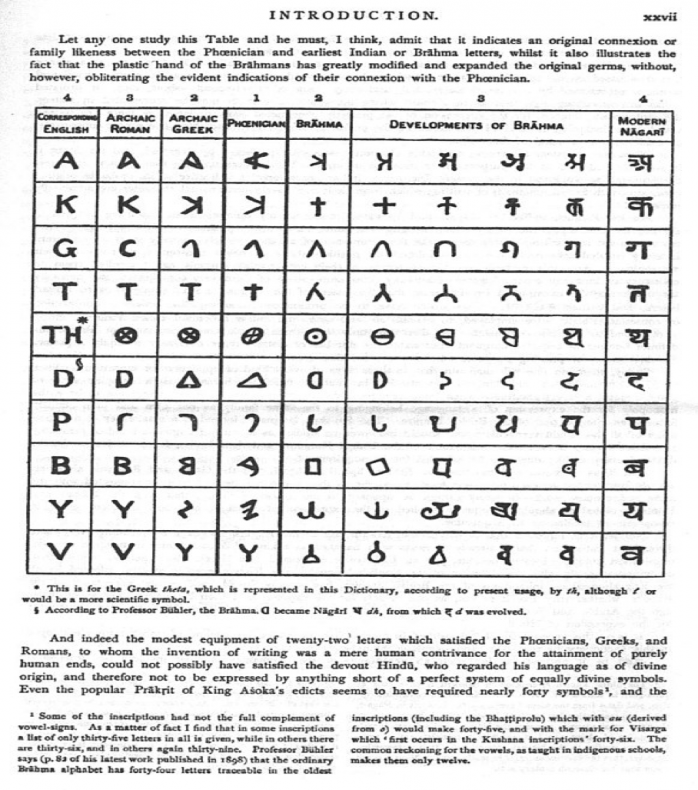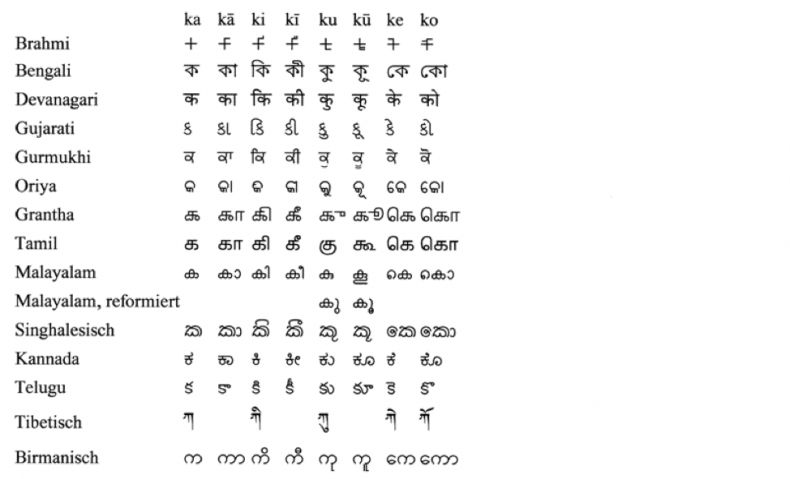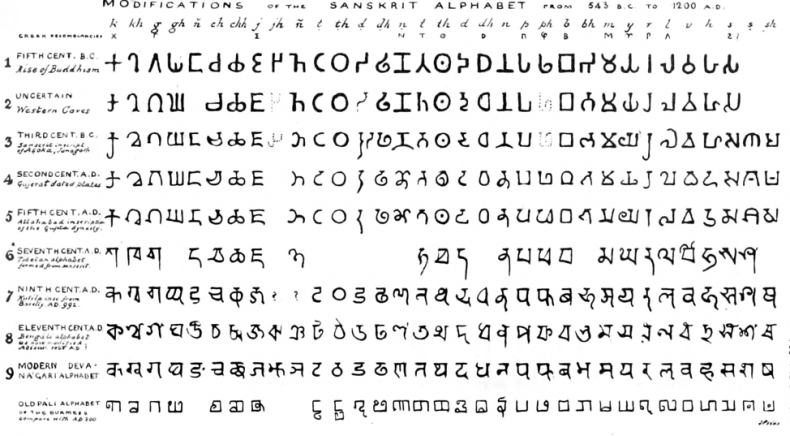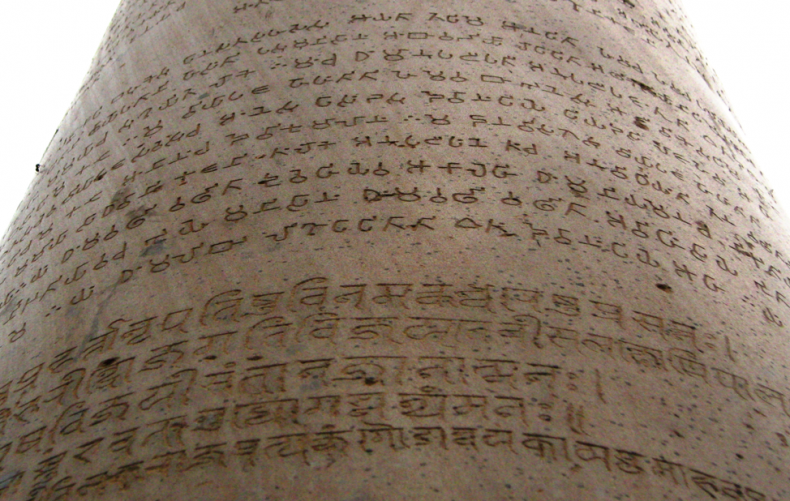Only a few years ago, things did not seem to be going well for India’s various alphabets, often known as the Indic or Brahmic scripts after the historical Iron Age script that is the ancestor of modern South and Southeast Asian writing systems. Digitalization and the widespread proliferation of Roman-alphabet keyboards in India meant that Indian users would often transcribe Indian languages using ad hoc Romanizations on the internet and via text.
Yet today, one can’t follow the Indian Twittersphere or Indian content on social media and the rest of the internet without noticing the recent proliferation of Indic script material, particularly Devanagari (the script used for Hindi, Marathi, and Nepali). Technology and innovation helped this process along, and instead of shrinking the sphere of Indic script usage, they allow Indic scripts to be used more broadly, especially at the popular level. The use of Unicode, and the spread of Indic script transliteration and typing interfaces on Google, and on phones—which is how most Indians access the Internet—have all made it much easier to publish online in Indic scripts. Many phones and computers in India are not specifically designed with Indic script keyboards and instead use the Roman alphabet keyboards common in the West. Transliteration software renders this moot. The increased use of Indic-language scripts has also lead to newer and more artistic fonts for Indian languages.
In short, this is a golden age for Indic language script usage, due to technology and increased literacy. This is despite both the proliferation of English-language education in India, and the shoddy quality of public schools in that country. The very nature of modernity, with its mass communication, advertisements, social platforms, and the spread of information and entertainment to everyone with a smartphone, means that everyone will eventually gain and utilize basic literacy, even if by osmosis and not formal education. And most of this literacy in India will be in local languages. This will be the first time in India’s recorded history that its scripts are being used so widely.
India has a long history of writing. While India has been a literate culture for millennia, it has also greatly valued oral knowledge. The ancient Hindu scriptures, the Vedas, the oldest of which dated to around 1500 BCE were memorized verbatim for at least a thousand years, if not more, before being committed to writing. The oldest writing found in the subcontinent is the as yet undeciphered script of the Indus Valley Civilization (IVC), which seems to have been somewhat logo-syllabic in nature. The script fell out of use by 1500 BCE.
The linguistic landscape of the subcontinent changed dramatically during the 2nd millennium BCE, so that is is impossible to determine if there is a connection between the IVC script and the next clearly attested script in India, the Brahmi script found in the inscriptions of the Mauryan Emperor Ashoka (ruled 268-232 BCE), especially since they probably represented vastly different, unrelated languages.
The sudden appearance of the Brahmi writing system is one of the great mysteries of writing in India, as there is no evidence of inscriptions beforehand. Another script, the (extinct, childless) Kharosthi of northwest Pakistan and Afghanistan seems to be clearly derived from the imperial Aramaic script used by the Persians who ruled over parts of the Indus Valley for two centuries until the arrival of Alexander the Great. It is unclear if the fully developed Brahmi script was invented by the Mauryan Empire as a result of exposure to Aramaic, but this seems unlikely, particularly since there were advanced states in the Ganges valley and a corpus of Vedic literature dating from before the Mauryan period.
It is more likely that pre-Mauryan inscriptions may still be discovered, and in fact, some Brahmi inscriptions have been found in Tamil Nadu and Sri Lanka dating to the 6th century BCE. Is it possible then, that writing spread from the south to the north, countervening the traditional notion that the Indic scripts originate in the Ganges valley? This may quite possibly be the case, especially since the coasts of southern India were more exposed to foreign trade from the Middle East than northern India, and scripts from traders could have been brought to India this way (the same way the Phoenicians brought their script to Greece). This long gestation period and overland route from southern to northern India may explain why the Brahmi script, even if it is vaguely derived from Middle Eastern alphabets, is so different and nativized, especially relative to the more obviously Middle Eastern-inspired Kharosthi.
Once the Brahmi script was spread throughout India by the subcontinent-wide Mauryan Empire, it was used by the subcontinent’s elites.However, unlike imperial China with its unified central government and bureaucratic exam system, and Christian and Muslim societies that were united by a written scripture, oral culture and regional differences in India led to the Brahmi script differentiating and evolving into different scripts in various regions of India, a phenomenon that was already occurring by the end of the Maruyan period in the 2nd century BCE. This phenomenon—each literary language having a particular and unique script—is not actually that unique to India, as the various languages of the ancient Near East and Mediterranean also evolved their own scripts from a common source.
The increased need for quicker, daily writing, versus use for monumental inscriptions may have led to the predominance of cursive styles that evolved into India’s modern scripts. Various other factors may have been at play, such as the material used for writing: in South India, scripts became more rounded, as a result of writing on palm leaves, while in North India, cloth and birch bark allowed for more angular lines, and indeed the major division amongst Brahmic scripts is between the southern Indian/Southeast Asian scripts and the northern Indian and Tibetan scripts.
Regional linguistic differences also helped Indic writing proliferate into many scripts in both South and Southeast Asia. It became prestigious for every major language to have its own script, though what evolved into today’s Devanagari (which began to emerge by the 7th century CE) script retained a special prestige due to its close association with Sanskrit. It is unclear if the evolution of Indic scripts into new forms would have ever stopped had it not been for the standardization process that is necessary for a print-oriented mass modern society. Relatively recently, for example, Devanagari spawned new, regional variations such as the Gujarati script, indicating that there was no real “final form” in the evolution of letter shapes in Indic writing. This seems to have remained the case, even when Indic-script users were exposed to the more unchanging Roman and Arabic alphabets.
The change in letter forms leading to new scripts was probably so slow, generation by generation, that the process did not necessarily involve conscious change from one script to another, but a slow evolution of differences in letter formation as texts were copied throughout the ages. A similar development occurred in medieval Europe with the Latin script, but the development of the printing press, and Renaissance ideas about how the Latin script ought to look like led to a typographical convergence.
The evolution of Brahmi into so many scripts over time in India does however raise the question of what individuals and scribes thought about the changes upon becoming aware—and they were aware, as inscriptions in multiple different Indian scripts have been found together, like Kannada with Devanagari—of the fact that their contemporary writing systems were divergent in separate regions, and were also vastly different from the forms found in inscriptions and ancient documents. While 19th century scribes of Indian scripts were unable to tell the British what was written on ancient pillars from the Mauryan Era (the British deciphered Brahmi in 1837), this inability to read ancient forms of writing does not always seem to be the case. In fact, there have been examples of Mauryan, Gupta, and early Nagari inscriptions found together, with each subsequent script alluding to the content of what was written before it in a predecessor script.
But that fact that this knowledge was lost over time and that Indian scripts differentiated into so many forms does seem to indicate that literacy was not widespread and was limited to pockets of individuals, a trend which probably accelerated due to the eclipse of a pan-Indian literary culture after the 12th century. Before the emergence of a modern, mass culture throughout India, writing styles and scripts were particular to regions, and even castes, with scribes and merchants often utilizing their own scripts, which were usually simpler forms of the more formal monumental alphabets used for official or religious purposes.
However, modern trends such as the emergence of a politically unified, subcontinent-wide state in India, new scholarship, and technology seem to be reversed the differentiation that has characterized Indian scripts for past 2,000 years. The literacy of hundred of millions of people in native scripts makes it unlikely that the shapes of letters used by millions of people everyday for communication will change anytime soon, as that would lead to confusion and a lack of communication. The standardization and use of some scripts for mass print and online have also led to the decline of caste and trade based scripts, as well as many local variations. Many hitherto unwritten modern languages are now written in established scripts, usually the script most prevalent in that particular state of India’s, instead of evolving a new script for the language.
While India’s scripts are ancient, technology and modernity are changing their usage patterns, and are in fact allowing them to thrive as never before in standardized and widely used forms, as more people gain literacy and access to the internet.






































